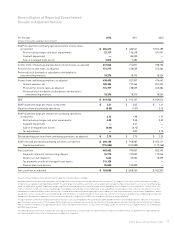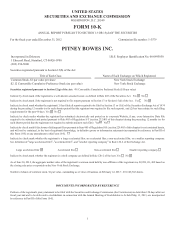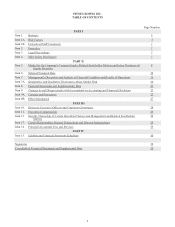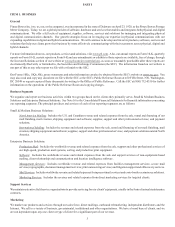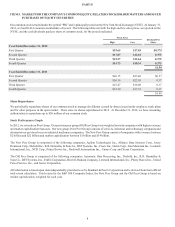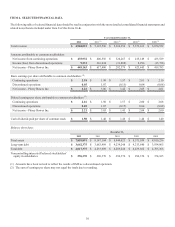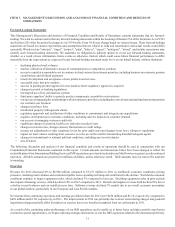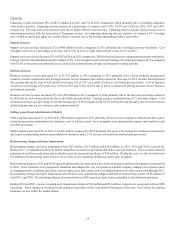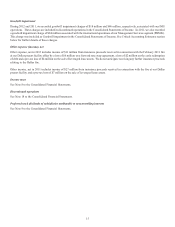Pitney Bowes 2012 Annual Report Download - page 23
Download and view the complete annual report
Please find page 23 of the 2012 Pitney Bowes annual report below. You can navigate through the pages in the report by either clicking on the pages listed below, or by using the keyword search tool below to find specific information within the annual report.5
ITEM 1A. RISK FACTORS
In addition to the disclosures and other information discussed in this report, the following risk factors should be considered in evaluating
our business. We work to manage and mitigate these risks proactively, including through the use of an enterprise risk management
program. Nevertheless, the following risks, some of which may be beyond our control, could materially impact our businesses, our brand
and reputation, financial condition and results of operations and may cause future results to be materially different than our current
expectations:
We are subject to postal regulations and processes, which could adversely affect our revenue and profitability.
The majority of our revenue is directly or indirectly subject to regulation and oversight by postal authorities worldwide. We depend on
a healthy postal sector in the geographic markets where we do business, which could be influenced positively or negatively by legislative
or regulatory changes in those countries. Our profitability and revenue in a particular country could be affected by adverse changes in
postal regulations, the business processes and practices of individual posts, the decision of a post to enter into particular markets in direct
competition with us and the impact of any of these changes on postal competitors that do not use our products or services. These changes
could affect product specifications, service offerings, client behavior and the overall mailing industry. Further, if we are found to have
violated postal regulations, we could be subject to fines or civil or criminal penalties.
An accelerated decline in physical mail volumes could have an increasingly adverse effect on our revenues and profitability as we
transition to more digital offerings and other services.
The use of postal services to send physical mail continues to decline, which has had an adverse effect on our revenues and profitability.
An accelerated or sudden decline in physical mail volumes could result from, among other things, changes in our clients' communication
behavior; changes in communications technologies; expansion of mobile Internet access; the growing trend by businesses to incent or
require their clients to use alternatives to mail for payments and statement presentment; government actions such as executive orders,
legislation or regulations that mandate electronic substitution, prohibit certain types of mailings, increase the difficulty of using information
or materials in the mail, or impose higher taxes or fees on mailing or postal services; and unexpected events such as the transmission of
biological or chemical agents or acts of terrorism.
We do not expect total mail volumes to rebound to prior peak levels. We have introduced various product and service offerings as
alternatives to physical mail. However, margin on these new product and service offerings are lower than our traditional mailing business;
there is no guarantee that these offerings will be widely accepted in the marketplace; and if accepted, they will face competition from
existing and emerging alternative products and services.
We may not realize the anticipated benefits of our strategic acquisitions and divestitures, which may harm our financial results.
We have made, and we may continue to make, strategic acquisitions and divestitures that involve significant risks and uncertainties,
including:
• challenges in identifying and evaluating the acquisitions and divestitures that best enable our future success;
• inability to complete acquisitions or divestitures on satisfactory terms or time frames or at all;
• loss of key employees or clients of businesses acquired or divested;
• difficulties in integrating newly acquired businesses and operations, including combining product and service offerings and
entering new markets;
• difficulties in reducing fixed costs previously associated with divested assets or businesses; and
• difficulties in identifying and separating intellectual property to be divested from intellectual property we wish to keep.
In addition, as we increase our focus towards providing more digital technology and software solutions for businesses while maintaining
a leadership role in the mailing industry, restructuring charges, asset impairments and other expenses may result. We may also need to
divert and/or dedicate management and other resources to complete the transactions. Furthermore, such transactions often have post-
closing arrangements including but not limited to post-closing adjustments, transition services, escrows or indemnifications, the financial
results of which can be difficult to predict. If we do not realize the anticipated benefits or synergies of our acquisitions and divestitures,
our consolidated financial position, results of operations, cash flows and stock price could be negatively affected.
We depend on third-party suppliers and outsource providers and our business could be adversely affected if we fail to manage these
constituents effectively.
We depend on third-party suppliers and outsource providers for a variety of services, components and supplies, including a large portion
of our product manufacturing and some non-core functions and operations. In certain instances, we rely on single sourced or limited
sourced suppliers and outsourcing vendors around the world because doing so is advantageous due to quality, price or lack of alternative
sources. If production or service was interrupted and we were not able to find alternate third-party suppliers, we could experience






